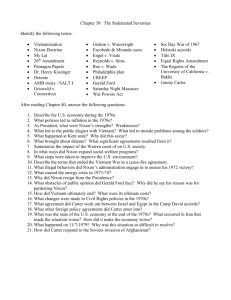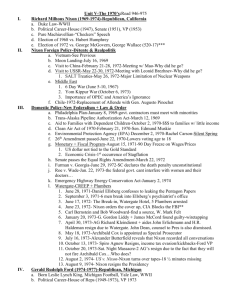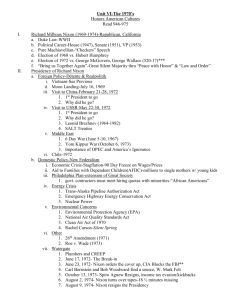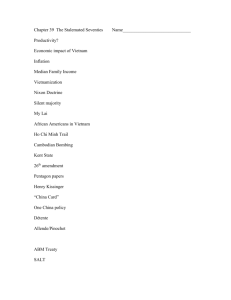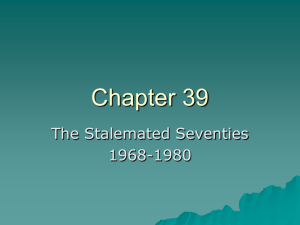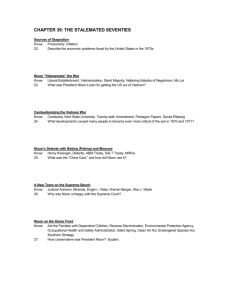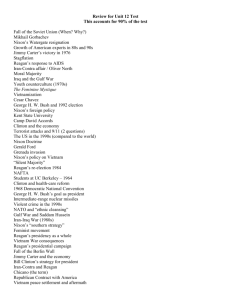chapter 31 - Pittsfield Public Schools
advertisement
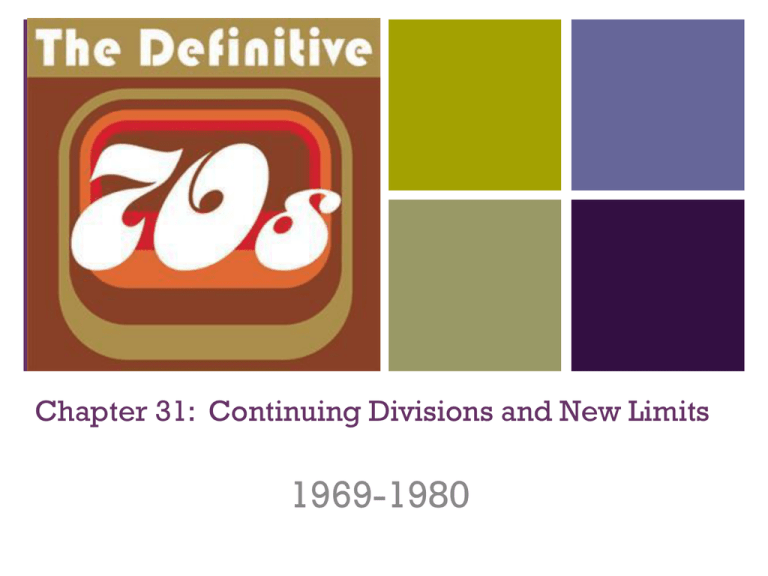
+ Chapter 31: Continuing Divisions and New Limits 1969-1980 For 5 minutes, talk with a + partner about everything you know about the decade of the 70s. + The New Politics of Identity I. A. 1. 2. B. 1. 2. 3. C. 1. 2. 3. 4. D. 1. 2. 3. E. 1. 2. African American Cultural Nationalism Black activists emphasized distinctiveness of black culture & society – growing hair into “naturals” & “afros” 1966 Kwanzaa created to offer a celebration of a shared African heritage Mexican American Activism 1970 9mil lived in SW – discriminated w/ work, pay, schools, etc. Migrant workers on strike against CA grape growers – United Farm Workers got attention (paid $0.10 when minimum wage was $1.25) Customers boycotted & workers rewarded better wages & conditions Chicano Movement Fed Alliance of Grants wanted return of land that ancestors owned before US 1969 National Chicano Liberation Youth Conference adopted manifesto to declare independence Introduced Chicano studies & culture in schools La Raza Unida was SW-based political party Native American Activism 11/1969 “Indians of All Tribes” went to Alcatraz Island demanding return of land – lasted 19 months, not successful National Congress of American Indians & Native American Rights Fund asked Congress to govern themselves Returned lots of land & passed Indian Self-Determinations & Edu Assistance Act Affirmative Action In court – hard to prove discrimination was intentional Philadelphia Plan ordered businesses to hire “minority” people + + I. The Women’s Movement and Gay Liberation Liberal and Radical Feminism A. 1. 1966 National Organization for Women wanted to enforce Civil Rights Act 2. Women treated as 2nd class citizens during war 3. “Bra-burners” = women who went to the Miss America Pageant to protest Accomplishments of the Women’s Movement B. 1. Worked for: Right of married women to get credit in her own name, right of single women to have birth control, right of women to be on juries, end of sexsegregated “help wanted” ads, dealing with rape victims. 2. 1973 Roe v. Wade Privacy rights let women have abortions 3. Equal Rights Amendment (ERA) no discrimination based on sex Opposition to the Women’s Movement C. 1. Some didn’t want to be equal – Believed it took away from fighting for racial equality 2. STOP-ERA Movement Believed there would be gov’t intervention in personal lives, decriminalize rape, use a unisex toilet, & have women in military draft 3. ERA falls 3 states short of ratification – expires in 1982 Gay Liberation D. 1. Pre-1973 homosexuality labeled as a mental disorder 2. 6/28/1969 NYPD raided Stonewall Inn b/c more than 3 homosexual men were in the bar at the same time – 1st time someone stood up to the police 3. By 1973 800 gay organizations in the US Bra-Burners The End in Vietnam I. Invasion of Cambodia A. 1. “Vietnamization” = building up South Vietnamese forces to replace US: 1969 543k troops, 1972 60k 2. 3/1969 US bombed Cambodia for 14 months – dropped over 100k tons of bombs from aircrafts 3. 4/1970 South Vietnam & US invaded Cambodia – after 2 months, US troops withdrew Protests and Counter Demonstrations B. 1. 450 college campuses on strike 2. May 4th Kent State University National Guardsmen fired & killed 4, wounded 11 3. 6/1971 Pentagon Papers – Americans learned leaders lied to them about aims and strategies in Southeast Asia Morale Problems in Military C. 1. Drug addiction, desertion, racial disorder, murder of unpopular officers (fragging) 2. My Lai Massacre (1968) = Lt William Calley charged with the killing of 300+ unarmed South Vietnamese civilians Paris Peace Accords D. 1. 12/1972 “Christmas Bombing” After failed peace agreement b/w North & South Vietnam – US launched massive air strike on North 2. 1/27/1973 Kissinger & Le Duc Tho signed cease-fire agreement in Paris – both violated and war erupted again 3. 4/29/1975 South Vietnamese gov’t collapsed & Vietnam reunified under Communist gov’t Costs of the Vietnam War E. 1. 58k+ US & 1.5-2m Vietnamese 2. 100ks civilians in Cambodia & Laos 3. Delayed accomodation w/ USSR & China, friction b/w Allies, & alienated 3rd world countries Debate Over the Lessons of Vietnam F. 1. “Vietnam Syndrome” = US suspicion of foreign entanglement – scared of becoming less powerful 2. Some blamed war on imperial presidency – let them act w/o restraint 3. 1973 War Powers Act To limit president’s war-making freedom – Congress had to approve any commitment of US forces to combat action lasting 60+ days Vietnam Veterans G. 1. Post traumatic stress disorder – some killed women, children, & elderly – felt guilty later 2. 1982 DC Vietnam Veterans Museum My Lai Massacre + Christmas Bombing + I. Nixon, Kissinger, and the World A. 1. B. 1. 2. 3. 4. C. 1. 2. D. 1. 2. 3. 4. E. 1. 2. 3. 4. Nixon Doctrine (7/1969) US would give economic aid to Allies, Allies shouldn’t rely on US troops Détente Measured cooperation w/ Soviets thru negotiations – to limit Soviet expansion & arms buildup Wanted to curb radicalism in 3rd world countries to avoid threats Soviets wanted détente b/c Cold War drained their resources 5/1972 ABM Treaty = b/w US & USSR – limit construction & deployment of intercontinental ballistic missiles Opening to China US wanted to end Sino-American hostility – China wanted to spur trade & make USSR scared 1972 trip to “Red China” Nixon met w/ Mao Zedong & Zhou Enlai – agreed to disagree on a lot except that USSR should not make gains in Asia Wars in the Middle East 1967 Arab-Israeli 6-day War – Israel victories against Egypt & Syria – took 28k sq mi 100ks in Gaza & West Peninsula that Israel took over – all wanted Israel gone 10/1973 (Yom Kippur) Egypt & Syria attacked Israel Organization of Petroleum Exporting Countries embargoed shipments of oil to US Anti-radicalism in Latin America & Africa 1970 Chile CIA started secret operation to overthrow pres Salvador Allende 1973 Installed authoritarian regime under Gen Augusto Pinochet South America Nixon supported white rulers who used segregation on blacks, keeping them poor, disenfranchised, & in prison-like towns US built ties and sent arms to Kenya and Congo + Presidential Politics and the Crisis of Leadership I. Nixon’s Domestic Agenda A. 1. Doubled National Endowment for Arts & Humanities & created Occupational Safety & Health Admin 2. Republicans = law & order, Democrats = permissiveness, crime, drugs, radicalism, “Hippie Lifestyle” 3. Proposed minimum wage for all citizens – wanted to get rid of fed welfare system & destroy liberal bureaucracy of social workers 4. “Southern strategy” = nominated 2 southerners for Supreme Ct – Congress declined 5. Ct upheld plan that required NC schools to desegregate by bussing children to other county schools Enemies & Dirty Tricks B. 1. Democratic nominee = George McGovern, opposed Vietnam War 2. 6/17 5 men caught breaking into Democratic National Committee’s Office – associated w/ Committee to Re-elect the President (Nixon won election) 3. “Enemy lists” = all black members of congress & Ivy League universities 4. Plumbers = bugged phones, infiltrated campaign staff – wrote & gave letters falsely accusing Democratic candidates of sexual misconduct Watergate Cover-up & Investigation C. 1. Nixon not involved – still made CIA stop investigation b/c of national security 2. Obstructed justice (an impeachable crime) – investigation stopped 3. Reporters Carl Bernstein & Bob Woodward continued investigation 4. Nixon recorded conversations in Oval Office – could prove his involvement, but he wouldn’t release them Impeachment & Resignation D. 1. 10/1973 VP Spiro Agnew resigned – accepted bribes while MD gov– Gerald Ford now VP 2. 10/24/1973 House began impeachment process – Nixon released edited tapes 3. 7/1974 Supreme Ct made Nixon release all tapes – found reasons to impeach him 4. 8/9/1974 became 1st president to resign 5. War Powers Act & 1974 Budget & Impoundment Control Act impossible for president to disregard congressional spending mandates + “I am not a crook” + E. F. Ford’s Presidency 1. Nation’s 1st unelected president 2. Pardoned Nixon – ending criminal charges, lost approval ratings (71%41%) 3. Routinely vetoed bills (39 in 1 yr) – Congress often overrode veto 4. Mocked & made fun of in political cartoons & SNL – portrayed as buffoon & klutz 5. 1st president to discover how much rules of changed b/c president was not respected & made fun of on national news when he slipped or made a mistake Carter as “Outsider” President 1. Jimmy Carter elected in 1976 – committed to racial equality & integration 2. Religious Christian that lacked political experience – used it to his advantage by promising the truth & emphasizing his distance from political corruption 3. Proposed to Congress an energy plan that emphasized conservation 4. Worked to ease gov’t regulations w/o destroying consumer & worker safeguards 5. Created Depts of Energy & Edu 6. Established $1.6bil “superfund” to clean up abandoned chemical waste sights – placed more than 100 mil acres of AK land under fed control as national parks & forests + Jimmy Carter’s Inaugural Speech + Economic Crisis I. A. 1. 2. 3. 4. 5. 6. B. 1. 2. 3. 4. C. 1. 2. 3. D. Stagflation & Its Causes Economy in “stagflation” = high unemployment & out of control inflation Gov’t tried to increase spending & reduce employment – inflation grew Tried to cut gov’t spending – recession & unemployment grew 1971 US imported more than exported US goods became more expensive & quality of goods declined Depended on imported oil – when OPEC cut off shipments, prices rose 350% Attempts to Fix the Economy Nixon ended gold-standard for $$ - increased price of foreign goods Ford created 1974 Whip Inflation Now to encourage anti-inflation efforts Carter’s attempt to lower unemployment prompted a recession in 1980 Carter’s 1978 economic policies helped later (deregulation of airline, trucking, banking, & communications) Impacts of the Economic Crisis 1970s economy shifted to “service sector” – retail, restaurants, etc. People moved from North industrial regions to the “Sunbelt” – had aerospace, defense, electronics, transportation, research, banking & finance, & leisure Population shift caused disaster in north & midwest cities Tax Revolts 2. Created as property taxes increased & taxpayers saw gov’t as the problem 1978 CA Proposition 13 rolled back property taxes & restricted future increases 3. Caused shortages – states cut schools, libraries, & fire stations 1. Credit & Investment E. 1. High inflation rates meant there were higher declines in purchasing power of a dollar 2. Began borrowing $ & used credit cards – caused high debt rates 3. Fidelity Investments = a fund company allowed small investors to get high interest rates + An Era of Cultural Transformation I. A. B. C. D. E. Environmentalism 1. 1969 Santa Barbara, CA oil spill caused Cuyahoga River to catch fire 2. 1979 Harrisburg, PA nuclear accident 3. 1980 Love Canal, NY Carter declared fed emergency b/c 30% of residents suffered from chromosome damage 4. 4/22/1970 1st Earth Day Technology 1. 7/20/1969 Neil Armstrong on moon 2. Poverty, crime, pollution, & urban decay 3. 1970 circuit created, 1975 MIT’s Altair 8800 – had 256 bytes of memory Religion & the Therapeutic Culture 1. Evangelical & Fundamentalist church membership grew dramatically 2. Others looked to “New Age” – Zen Buddhism, yoga, & shamanism 3. “Therapeutic culture” – some believed was self-centered Sexuality & the Family 1. Sex became much more visible in American culture 2. TV programs less strict 3. Single bars & gay bathhouses 4. Started marrying later in life & had fewer children Diversity 1. Awareness of differences made stronger by new immigrants from Latin America & Asia 2. 1978 Regents of the University of CA v. Bakke 33 yr old white man denied admission to med school – believed it was b/c he was white 3. Supreme Ct decided in favor of Allan Bakke + Neil Armstrong on the Moon + Renewed Cold War and Middle East Crisis I. A. 1. 2. 3. 4. B. 1. 2. 3. 4. C. 1. 2. 3. 4. 5. D. 1. 2. 3. 4. E. 1. 2. Carter’s Divided Administration Carter listened to national security advisor more than his secretary of state 1976 magazine criticized Carter’s relaxed take of the Cold War Maintained good relations w/ Moscow & other countries around the world 1977 signed 2 treaties w/ Panama Camp David Accords 9/1978 1st mediated peace treaty b/w Israel & an Arab nation Israel promised to withdraw from the Sinai peninsula Arab states denounced agreement for not requiring Israel to relinquish all occupied territories Ended warfare along 1 frontier Soviet Invasion of Afghanistan Relations w/ Moscow had deteriorated Soviets wanted to deploy missiles at western Europe 12/1979 Soviets invaded Afghanistan b/c of strategic position Carter suspended shipments of grain & high-tech equipment to USSR 1980 boycotted Summer Olympics in Moscow Iranian Hostage Crisis Shah driven from throne b/c it was trying to modernize culture 4/1979 Islamic revolutionaries proclaimed Shi’ite Islamic Republic 11/1979 mobs stormed US Embassy in Teheran & took Americans hostage & demanded that the Shah stood trial 4/1980 Carter broke diplomatic ties & ordered rescue mission Rise of Saddam Hussein 1979 became leader & threatened Teheran gov’t – US thought he would offset Iranian danger 9/1979 war began & US was neutral, but soon went towards Iraq

